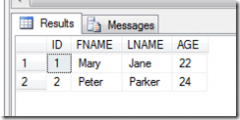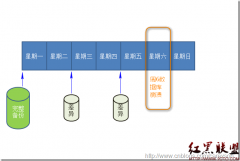Sql Server参数化查询之where in和like实现详解
来源:未知 责任编辑:智问网络 发表时间:2013-11-10 20:25 点击:次
身为一名小小的程序猿,在日常开发中不可以避免的要和where in和like打交道,在大多数情况下我们传的参数不多简单做下单引号、敏感字符转义之后就直接拼进了SQL,执行查询,搞定。若有一天你不可避免的需要提高SQL的查询性能,需要一次性where in 几百、上千、甚至上万条数据时,参数化查询将是必然进行的选择。然而如何实现where in和like的参数化查询,是个让不少人头疼的问题。
where in 的参数化查询实现
首先说一下我们常用的办法,直接拼SQL实现,一般情况下都能满足需要
www.2cto.com
string userIds = "1,2,3,4";
using (SqlConnection conn = new SqlConnection(connectionString))
{
conn.Open();
SqlCommand comm = new SqlCommand();
comm.Connection = conn;
comm.CommandText = string.Format("select * from Users(nolock) where UserID in({0})", userIds);
comm.ExecuteNonQuery();
}
需要参数化查询时进行的尝试,很显然如下这样执行SQL会报错错误
using (SqlConnection conn = new SqlConnection(connectionString))
{
conn.Open();
SqlCommand comm = new SqlCommand();
comm.Connection = conn;
comm.CommandText = "select * from Users(nolock) where UserID in(@UserID)";
comm.Parameters.Add(new SqlParameter("@UserID", SqlDbType.VarChar, -1) { Value = "1,2,3,4" }); www.2cto.com
comm.ExecuteNonQuery();
}
很显然这样会报错误:在将 varchar 值 '1,2,3,4' 转换成数据类型 int 时失败,因为参数类型为字符串,where in时会把@UserID当做一个字符串来处理,相当于实际执行了如下语句
select * from Users(nolock) where UserID in('1,2,3,4')
若执行的语句为字符串类型的,SQL执行不会报错,当然也不会查询出任何结果
using (SqlConnection conn = new SqlConnection(connectionString))
{
conn.Open();
SqlCommand comm = new SqlCommand();
comm.Connection = conn;
comm.CommandText = "select * from Users(nolock) where UserName in(@UserName)";
comm.Parameters.Add(new SqlParameter("@UserName", SqlDbType.VarChar, -1) { Value = "'john','dudu','rabbit'" });
comm.ExecuteNonQuery();
}
这样不会抱任何错误,也查不出想要的结果,因为这个@UserName被当做一个字符串来处理,实际相当于执行如下语句
select * from Users(nolock) where UserName in('''john'',''dudu'',''rabbit''')
由此相信大家对于为何简单的where in 传参无法得到正确的结果知道为什么了吧,下面我们来看一看如何实现正确的参数化执行where in,为了真正实现参数化where in 传参,很多淫才想到了各种替代方案
方案1,使用CHARINDEX或like 方法实现参数化查询,毫无疑问,这种方法成功了,而且成功的复用了查询计划,但同时也彻底的让查询索引失效(在此不探讨索引话题),造成的后果是全表扫描,如果表里数据量很大,百万级、千万级甚至更多,这样的写法将造成灾难性后果;如果数据量比较小、只想借助参数化实现防止SQL注入的话这样写也无可厚非,还是得看具体需求。(不推荐)
using (SqlConnection conn = new SqlConnection(connectionString))
{
conn.Open();
SqlCommand comm = new SqlCommand();
comm.Connection = conn;
//使用CHARINDEX,实现参数化查询,可以复用查询计划,同时会使索引失效
comm.CommandText = "select * from Users(nolock) where CHARINDEX(','+ltrim(str(UserID))+',',','+@UserID+',')>0";
comm.Parameters.Add(new SqlParameter("@UserID", SqlDbType.VarChar, -1) { Value = "1,2,3,4" });
comm.ExecuteNonQuery();
}
using (SqlConnection conn = new SqlConnection(connectionString))
{
conn.Open();
SqlCommand comm = new SqlCommand();
comm.Connection = conn;
//使用like,实现参数化查询,可以复用查询计划,同时会使索引失效
comm.CommandText = "select * from Users(nolock) where ','+@UserID+',' like '%,'+ltrim(str(UserID))+',%' ";
comm.Parameters.Add(new SqlParameter("@UserID", SqlDbType.VarChar, -1) { Value = "1,2,3,4" }); www.2cto.com
comm.ExecuteNonQuery();
}
方案2 使用exec动态执行SQL,这样的写法毫无疑问是很成功的,而且代码也比较优雅,也起到了防止SQL注入的作用,看上去很完美,不过这种写法和直接拼SQL执行没啥实质性的区别,查询计划没有得到复用,对于性能提升没任何帮助,颇有种脱了裤子放屁的感觉,但也不失为一种解决方案。(不推荐)
using (SqlConnection conn = new SqlConnection(connectionString))
{
conn.Open();
SqlCommand comm = new SqlCommand();
comm.Connection = conn;
//使用exec动态执行SQL
//实际执行的查询计划为(@UserID varchar(max))select * from Users(nolock) where UserID in (1,2,3,4)
//不是预期的(@UserID varchar(max))exec('select * from Users(nolock) where UserID in ('+@UserID+')')
comm.CommandText = "exec('select * from Users(nolock) where UserID in ('+@UserID+')')";
comm.Parameters.Add(new SqlParameter("@UserID", SqlDbType.VarChar, -1) { Value = "1,2,3,4" });
comm.ExecuteNonQuery();
}
方案3 为where in的每一个参数生成一个参数,写法上比较麻烦些,传输的参数个数有限制,最多2100个,可以根据需要使用此方案(推荐)
using (SqlConnection conn = new SqlConnection(connectionString))
{
conn.Open();
SqlCommand comm = new SqlCommand();
comm.Connection = conn;
//为每一条数据添加一个参数
comm.CommandText = "select * from Users(nolock) where UserID in (@UserID1,@UserId2,@UserID3,@UserID4)";
comm.Parameters.AddRange(
new SqlParameter[]{ www.2cto.com
new SqlParameter("@UserID1", SqlDbType.Int) { Value = 1},
new SqlParameter("@UserID2", SqlDbType.Int) { Value = 2},
new SqlParameter("@UserID3", SqlDbType.Int) { Value = 3},
new SqlParameter("@UserID4", SqlDbType.Int) { Value = 4}
});
comm.ExecuteNonQuery();
}
方案4 使用临时表实现(也可以使用表变量性能上可能会更加好些),写法实现上比较繁琐些,可以根据需要写个通用的where in临时表查询的方法,以供不时之需,个人比较推崇这种写法,能够使查询计划得到复用而且对索引也能有效的利用,不过由于需要创建临时表,会带来额外的IO开销,若查询频率很高,每次的数据不多时还是建议使用方案3,若查询数据条数较多,尤其是上千条甚至上万条时,强烈建议使用此方案,可以带来巨大的性能提升(强烈推荐)
using (SqlConnection conn = new SqlConnection(connectionString))
{
conn.Open();
SqlCommand comm = new SqlCommand();
comm.Connection = conn;
string sql = @"
declare @Temp_Variable varchar(max)
create table #Temp_Table(Item varchar(max))
while(LEN(@Temp_Array) > 0)
begin
if(CHARINDEX(',',@Temp_Array) = 0)
begin
set @Temp_Variable = @Temp_Array
set @Temp_Array = ''
end
else
begin
set @Temp_Variable = LEFT(@Temp_Array,CHARINDEX(',',@Temp_Array)-1)
set @Temp_Array = RIGHT(@Temp_Array,LEN(@Temp_Array)-LEN(@Temp_Variable)-1) www.2cto.com
end
insert into #Temp_Table(Item) values(@Temp_Variable)
end
select * from Users(nolock) where exists(select 1 from #Temp_Table(nolock) where #Temp_Table.Item=Users.UserID)
drop table #Temp_Table";
comm.CommandText = sql;
comm.Parameters.Add(new SqlParameter("@Temp_Array", SqlDbType.VarChar, -1) { Value = "1,2,3,4" });
comm.ExecuteNonQuery();
}
like参数化查询
like查询根据个人习惯将通配符写到参数值中或在SQL拼接都可,两种方法执行效果一样,在此不在详述
using (SqlConnection conn = new SqlConnection(connectionString))
{
conn.Open();
SqlCommand comm = new SqlCommand();
comm.Connection = conn;
//将 % 写到参数值中
comm.CommandText = "select * from Users(nolock) where UserName like @UserName";
comm.Parameters.Add(new SqlParameter("@UserName", SqlDbType.VarChar, 200) { Value = "rabbit%" });
comm.ExecuteNonQuery();
}
using (SqlConnection conn = new SqlConnection(connectionString))
{
conn.Open();
SqlCommand comm = new SqlCommand();
comm.Connection = conn;
//SQL中拼接 % www.2cto.com
comm.CommandText = "select * from Users(nolock) where UserName like @UserName+'%'";
comm.Parameters.Add(new SqlParameter("@UserName", SqlDbType.VarChar, 200) { Value = "rabbit%" });
comm.ExecuteNonQuery();
}
本文出自 http://www.cnblogs.com/lzrabbit/archive/2012/04/22/2465313.html
相关新闻>>
最新推荐更多>>>
- 发表评论
-
- 最新评论 进入详细评论页>>




